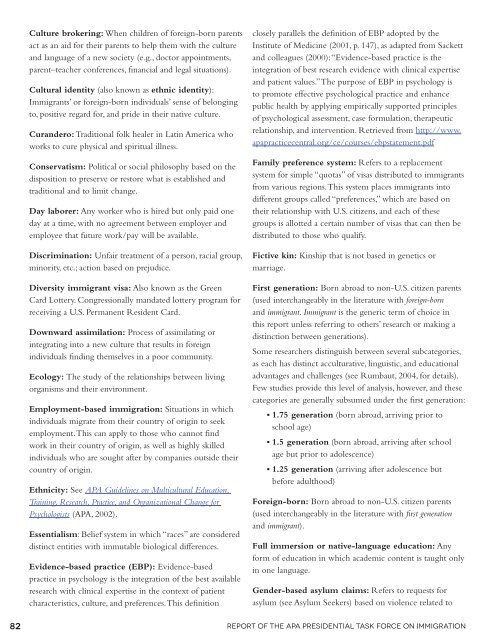Crossroads: The Psychology of Immigration in the New Century
Crossroads: The Psychology of Immigration in the New Century
Crossroads: The Psychology of Immigration in the New Century
Create successful ePaper yourself
Turn your PDF publications into a flip-book with our unique Google optimized e-Paper software.
Culture broker<strong>in</strong>g: When children <strong>of</strong> foreign-born parents<br />
act as an aid for <strong>the</strong>ir parents to help <strong>the</strong>m with <strong>the</strong> culture<br />
and language <strong>of</strong> a new society (e.g., doctor appo<strong>in</strong>tments,<br />
parent–teacher conferences, f<strong>in</strong>ancial and legal situations).<br />
Cultural identity (also known as ethnic identity):<br />
Immigrants’ or foreign-born <strong>in</strong>dividuals’ sense <strong>of</strong> belong<strong>in</strong>g<br />
to, positive regard for, and pride <strong>in</strong> <strong>the</strong>ir native culture.<br />
Curandero: Traditional folk healer <strong>in</strong> Lat<strong>in</strong> America who<br />
works to cure physical and spiritual illness.<br />
Conservatism: Political or social philosophy based on <strong>the</strong><br />
disposition to preserve or restore what is established and<br />
traditional and to limit change.<br />
Day laborer: Any worker who is hired but only paid one<br />
day at a time, with no agreement between employer and<br />
employee that future work/pay will be available.<br />
Discrim<strong>in</strong>ation: Unfair treatment <strong>of</strong> a person, racial group,<br />
m<strong>in</strong>ority, etc.; action based on prejudice.<br />
Diversity immigrant visa: Also known as <strong>the</strong> Green<br />
Card Lottery. Congressionally mandated lottery program for<br />
receiv<strong>in</strong>g a U.S. Permanent Resident Card.<br />
Downward assimilation: Process <strong>of</strong> assimilat<strong>in</strong>g or<br />
<strong>in</strong>tegrat<strong>in</strong>g <strong>in</strong>to a new culture that results <strong>in</strong> foreign<br />
<strong>in</strong>dividuals f<strong>in</strong>d<strong>in</strong>g <strong>the</strong>mselves <strong>in</strong> a poor community.<br />
Ecology: <strong>The</strong> study <strong>of</strong> <strong>the</strong> relationships between liv<strong>in</strong>g<br />
organisms and <strong>the</strong>ir environment.<br />
Employment-based immigration: Situations <strong>in</strong> which<br />
<strong>in</strong>dividuals migrate from <strong>the</strong>ir country <strong>of</strong> orig<strong>in</strong> to seek<br />
employment. This can apply to those who cannot f<strong>in</strong>d<br />
work <strong>in</strong> <strong>the</strong>ir country <strong>of</strong> orig<strong>in</strong>, as well as highly skilled<br />
<strong>in</strong>dividuals who are sought after by companies outside <strong>the</strong>ir<br />
country <strong>of</strong> orig<strong>in</strong>.<br />
Ethnicity: See APA Guidel<strong>in</strong>es on Multicultural Education,<br />
Tra<strong>in</strong><strong>in</strong>g, Research, Practice, and Organizational Change for<br />
Psychologists (APA, 2002).<br />
Essentialism: Belief system <strong>in</strong> which “races” are considered<br />
dist<strong>in</strong>ct entities with immutable biological differences.<br />
Evidence-based practice (EbP): Evidence-based<br />
practice <strong>in</strong> psychology is <strong>the</strong> <strong>in</strong>tegration <strong>of</strong> <strong>the</strong> best available<br />
research with cl<strong>in</strong>ical expertise <strong>in</strong> <strong>the</strong> context <strong>of</strong> patient<br />
characteristics, culture, and preferences. This def<strong>in</strong>ition<br />
closely parallels <strong>the</strong> def<strong>in</strong>ition <strong>of</strong> EBP adopted by <strong>the</strong><br />
Institute <strong>of</strong> Medic<strong>in</strong>e (2001, p. 147), as adapted from Sackett<br />
and colleagues (2000): “Evidence-based practice is <strong>the</strong><br />
<strong>in</strong>tegration <strong>of</strong> best research evidence with cl<strong>in</strong>ical expertise<br />
and patient values.” <strong>The</strong> purpose <strong>of</strong> EBP <strong>in</strong> psychology is<br />
to promote effective psychological practice and enhance<br />
public health by apply<strong>in</strong>g empirically supported pr<strong>in</strong>ciples<br />
<strong>of</strong> psychological assessment, case formulation, <strong>the</strong>rapeutic<br />
relationship, and <strong>in</strong>tervention. Retrieved from http://www.<br />
apapracticecentral.org/ce/courses/ebpstatement.pdf<br />
Family preference system: Refers to a replacement<br />
system for simple “quotas” <strong>of</strong> visas distributed to immigrants<br />
from various regions. This system places immigrants <strong>in</strong>to<br />
different groups called “preferences,” which are based on<br />
<strong>the</strong>ir relationship with U.S. citizens, and each <strong>of</strong> <strong>the</strong>se<br />
groups is allotted a certa<strong>in</strong> number <strong>of</strong> visas that can <strong>the</strong>n be<br />
distributed to those who qualify.<br />
Fictive k<strong>in</strong>: K<strong>in</strong>ship that is not based <strong>in</strong> genetics or<br />
marriage.<br />
First generation: Born abroad to non-U.S. citizen parents<br />
(used <strong>in</strong>terchangeably <strong>in</strong> <strong>the</strong> literature with foreign-born<br />
and immigrant. Immigrant is <strong>the</strong> generic term <strong>of</strong> choice <strong>in</strong><br />
this report unless referr<strong>in</strong>g to o<strong>the</strong>rs’ research or mak<strong>in</strong>g a<br />
dist<strong>in</strong>ction between generations).<br />
Some researchers dist<strong>in</strong>guish between several subcategories,<br />
as each has dist<strong>in</strong>ct acculturative, l<strong>in</strong>guistic, and educational<br />
advantages and challenges (see Rumbaut, 2004, for details).<br />
Few studies provide this level <strong>of</strong> analysis, however, and <strong>the</strong>se<br />
categories are generally subsumed under <strong>the</strong> first generation:<br />
J 1.75 generation (born abroad, arriv<strong>in</strong>g prior to<br />
school age)<br />
J 1.5 generation (born abroad, arriv<strong>in</strong>g after school<br />
age but prior to adolescence)<br />
J 1.25 generation (arriv<strong>in</strong>g after adolescence but<br />
before adulthood)<br />
Foreign-born: Born abroad to non-U.S. citizen parents<br />
(used <strong>in</strong>terchangeably <strong>in</strong> <strong>the</strong> literature with first generation<br />
and immigrant).<br />
Full immersion or native-language education: Any<br />
form <strong>of</strong> education <strong>in</strong> which academic content is taught only<br />
<strong>in</strong> one language.<br />
Gender-based asylum claims: Refers to requests for<br />
asylum (see Asylum Seekers) based on violence related to<br />
82 Report <strong>of</strong> <strong>the</strong> APA Presidential Task Force on <strong>Immigration</strong>
















